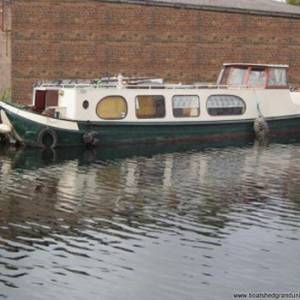
Choosing a Boat Part 1- Boat Types
This is the first blog in the series we introduced last week, designed to answer many of the stock question about the process of buying, then looking after a boat.
What types are there
Canal and river boats come in many shapes and sizes as well as a variety of materials, so let's start with the basics. Narrowboats range from around 20ft to around 70ft in length, but are generally 6'10" wide. They are traditionally measured in feet rather than metres, although we give both on the Boatshed Grand Union web site.
Anything wider than 7ft is a wide beam or broad beam. They are usually from 40ft up to 70ft. For want of a better description they are like a narrowboat only wider - 10', 10'6" and 12' are common widths although I have seen them down to 8' and up to 14'.
Both Narrowboats and Wide-beams generally have an open front deck, which can be enclosed with a removable covering called a cratch. The stern can be one of three configurations: traditional - very short, just enough room for the tiller swing - the helmsman stands in the hatch. Semi-trad - like a trad, but the roof over the engine space is removed and bench seats placed against the side walls. Cruiser stern- a larger more open stern often with a low rail around it.
A standard layout for a narrowboat or wide-beam is to have a lounge or saloon at the front, followed by a kitchen or galley, then the bathroom and finally a bedroom before reaching the engine space. Older, more traditional boats may have a full height engine room with, possibly a traditional boatman's cabin aft of that. Longer boats may have a second bedroom or utility room inserted in the plan. Boats with a bedroom in the front and a kitchen or living space right at the back are referred to as 'reverse layout'. These are becoming more popular.
Dutch barges are generally bigger and higher than wide beams and often will not fit under canal bridges. Some have a demountable wheel house and a lowering mast to allow canal passage. They come in many styles - Luxemotor, Aak and Tjalk are some of the better known ones. They tend to be more shapely than narrowboats with curved hulls and superstructure. Originally designed for Dutch Canals and Inland seas they were designed to sail as well as motor and often have a descending keel on one side. There are originals going back to the early twentieth-century available in this country as well as many replicas which are still being built in the UK. We also have similar, home grown, Humber and Thames barges.
All the above are generally steel built, although earlier ones are often wooden construction. Narrowboats also come in aluminium. Some boats are hybrid with a steel hull and wooden or aluminium (or even plastic) superstructure. River cruisers come in steel, GRP (Glass Reinforced Plastic) or wood.
Our next blog will cover which boats are most suitable for which purposes.
OTHER BLOGS IN THE SERIES:
How to Buy a Boat
Useful Links:
Boatshed Grand Union Canal and Narrowboats
A Wikipedia Article about Narrowboats
Pictures of Histroic Narrowboats

